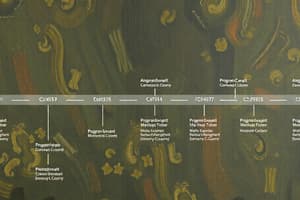Podcast
Questions and Answers
Which stage of the program development life cycle involves breaking down complex problems into smaller parts?
Which stage of the program development life cycle involves breaking down complex problems into smaller parts?
- Coding
- Analysis (correct)
- Design
- Testing
What is the purpose of top-down design in developing a computer system?
What is the purpose of top-down design in developing a computer system?
- To break down each part of the problem into more manageable problems (correct)
- To break down the problem into inputs, processes, outputs, and storage
- To document how the program should be developed
- To develop each sub-system as a sub-routine
What is the process of developing a program or set of programs and testing each module until it performs as required?
What is the process of developing a program or set of programs and testing each module until it performs as required?
- Design
- Maintenance
- Coding and iterative testing (correct)
- Analysis
Flashcards are hidden until you start studying
Study Notes
The Program Development Life Cycle and Computer System Design
- The program development life cycle consists of five stages: analysis, design, coding, testing, and maintenance.
- The analysis stage involves defining the problem and creating a requirements specification for the program using abstraction and decomposition tools.
- Abstraction keeps only the necessary elements for the solution and discards unnecessary details, while decomposition breaks down complex problems into smaller parts.
- The design stage uses the program specification from the analysis stage to document how the program should be developed.
- Formal documentation can be created using structure charts, flowcharts, and pseudocode.
- The coding and iterative testing stage involves developing the program or set of programs, writing each module using a suitable programming language, and testing each module until it performs as required.
- The testing stage involves running the completed program or set of programs multiple times with different test data to ensure that all tasks work together as specified in the program design.
- A computer system is made up of software, data, hardware, communications, and people, and can be divided into sub-systems using top-down design.
- Each sub-system can be developed as a sub-routine by a programmer, and the process of breaking down into smaller sub-systems is called stepwise refinement.
- Top-down design is an effective way of designing a computer system to provide a solution to a problem, as each part of the problem is broken down into more manageable problems.
- Decomposing a problem into inputs, processes, outputs, and storage is necessary for developing a computer system for its solution.
- This structured approach works for both large and small computer systems, and reduces development and testing time.
Studying That Suits You
Use AI to generate personalized quizzes and flashcards to suit your learning preferences.




